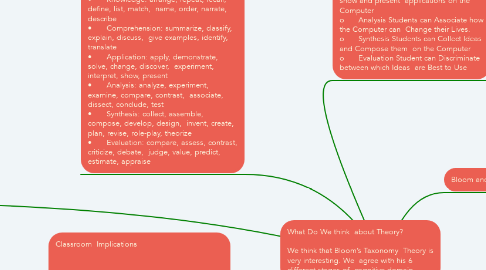Bloom’s Taxonomy
by Ruchi Mishra

1. What the Student does with Technology o Knowledge Students know the Parts of the Computer o Comprehension Students know what the Parts of the Computer are use for. o Application Students know how to show and present applications on the Computer o Analysis Students can Associate how the Computer can Change their Lives. o Synthesis Students can Collect Ideas and Compose them on the Computer o Evaluation Student can Discriminate between which Ideas are Best to Use
2. What the Teacher does with Technology o Knowledge is Teaching the parts of the Computer o Comprehension is Teaching the Students what the Parts of the Computer Do o Application is Teaching the Students how to Apply and Demonstrate the Use of the Computer o Analysis is Teaching the Students how the Computer can Change Their Lives o Synthesis is Teaching the Student how to Integrate Everything the Computer Can Do into One Element o Evaluation is Teaching the Student to make a Value Judgment about the Computer
3. Skills / Learning Objectives • Knowledge: arrange, repeat, recall, define, list, match, name, order, narrate, describe • Comprehension: summarize, classify, explain, discuss, give examples, identify, translate • Application: apply, demonstrate, solve, change, discover, experiment, interpret, show, present • Analysis: analyze, experiment, examine, compare, contrast, associate, dissect, conclude, test • Synthesis: collect, assemble, compose, develop, design, invent, create, plan, revise, role-play, theorize • Evaluation: compare, assess, contrast, criticize, debate, judge, value, predict, estimate, appraise
4. What Do We think about Theory? We think that Bloom’s Taxonomy Theory is very interesting. We agree with his 6 different stages of cognitive domain.
5. Classroom Implications In Bloom’s Taxonomy of Learning Cognitive domain, Bloom believes there are 6 levels to learning: • knowledge, comprehension, application, analysis, synthesis, and evaluation. • In knowledge stage, he believes teacher recite things so the students can recall the information. • In comprehension stage, have teachers ask open ended questions for students to have the freedom to respond how they want to evaluate comprehension of topic. • In application stage, teacher needs to use concept taught in a new situation so students to apply what they learned to a different situation. • In analysis stage, teachers need to give situation to student and have them come up with how to resolve situation. • In synthesis stage: teacher gives students certain items and ask students to build something. • In evaluation, teachers should tell their students how they have done with their work so the students can learn from it. •
6. Bloom and Mastery Learning
7. • Bloom believed that all children can learn and aimed to demonstrate that through is research • Bloom’s Taxonomy has been linked to the idea and goal of mastery learning • Mastery Learning: a model for learning in which students continue to gain information and knowledge, working through modules or teacher instruction only after they have mastered the content of the previous modules • Bloom believed that all children can learn given the correct conditions for learning and sufficient time • The principal part of creating the correct conditions for learning is by changing the methods of instruction


